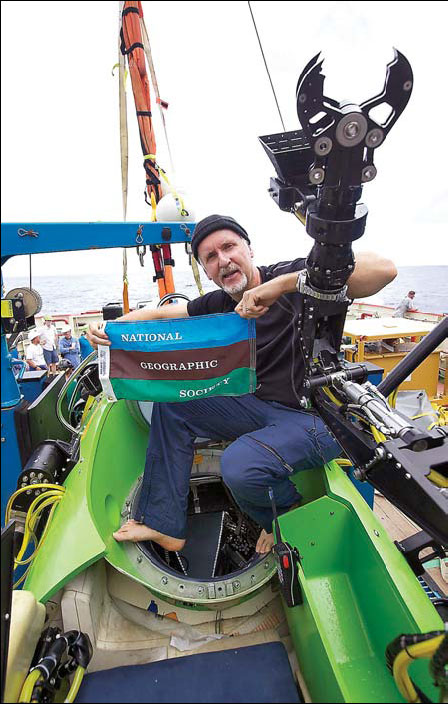James Cameron goes into the deep
Updated: 2012-03-27 08:25
By Associated Press in Honolulu (China Daily)
|
||||||||
Hollywood director James Cameron dove to the Earth's deepest point in a specially designed submarine, the National Geographic Society said, making him the first man to travel alone on the nearly 11-kilometer journey to the depths of the Mariana Trench.
|
Hollywood director and National Geographic Explorer-in-Residence James Cameron holds the National Geographic Society flag after he successfully completed the first-ever solo dive to the Mariana Trench on Monday. The dive was part of Deepsea Challenge, a joint scientific expedition by Cameron, the National Geographic Society and Rolex, to conduct deep-ocean research. [Mark Theissen / National Geographic via Associated Press] |
The director of Titanic, Avatar and other films touched down in the western Pacific Ocean's low point shortly before 8 am local time Monday, National Geographic said.
He reached a depth of 10,898 meters and stayed on the bottom for about three hours before he began his return to the surface, according to information provided by the expedition team. He had planned to spend up to six hours on the sea floor.
"Cameron collected samples for research in marine biology, microbiology, astrobiology, marine geology and geophysics," the organization said.
He also spent time filming the Mariana Trench, about 322 kilometers southwest of the Pacific island of Guam.
The trip to the deepest point took two hours and 36 minutes. But Cameron's return aboard his 12-ton, lime-green sub called Deepsea Challenger was a "faster-than-expected 70-minute ascent," according to National Geographic. A helicopter spotted the submersible bobbing in the water and it was brought aboard the ship by a crane.
There were no immediate reports regarding Cameron's well-being. A medical team was present when Cameron, 57, emerged from the sub, according to the expedition.
Expedition physician Joe MacInnis told National Geographic News before the journey that recent test dives, including one that went more than 8 kilometers deep, had gone well and that he expected Cameron would be fine.
"Jim is going to be a little bit stiff and sore from the cramped position, but he's in really good shape for his age, so I don't expect any problems at all," said MacInnis, a long-time Cameron friend, according to National Geographic.
Cameron also captured still photographs and video, but there was no immediate word on when the images will be released. The Geographic said the expedition is being chronicled for a 3-D feature film for theatrical release and subsequent TV broadcast.
"There is scientific value in getting stereo images because ... you can determine the scale and distance of objects from stereo pairs that you can't from 2-D images," Cameron told the Geographic before the dive.
The scale of the trench is hard to grasp - it's 120 times larger than the Grand Canyon and more than a mile deeper than Qomolangma, or known as Mount Everest in the West, is tall.
"It's really the first time that human eyes have had an opportunity to gaze upon what is a very alien landscape," said Terry Garcia, the National Geographic Society's executive VP for mission programs, via phone from Scotland.
Among the 2.5-story-tall sub's tools were a sediment sampler, a robotic claw, a "slurp gun" for sucking up small sea creatures for study at the surface, and temperature, salinity and pressure gauges.
Swiss engineer Jacques Piccard and Don Walsh, a US Navy captain, are the only others to reach the spot. They spent about 20 minutes there during their 1960 dive but couldn't see much after their sub kicked up sand from the sea floor.
One of the risks of a dive so deep was extreme water pressure. At 10.9 kilometers below the surface, the pressure is the equivalent of three SUVs sitting on your toe.
Cameron told The Associated Press in an interview after a 8.2- kilometer practice run near Papua New Guinea earlier this month that the pressure "is in the back of your mind". The submarine would implode in an instant if it leaked, he said.
But while he was a little apprehensive beforehand, he wasn't scared or nervous while underwater.
"When you are actually on the dive you have to trust the engineering was done right," he said.
The film director has been an oceanography enthusiast since childhood and has made 72 deep-sea submersible dives. Thirty-three of those dives have been to the wreckage of the Titanic, the subject of his 1997 hit film, which is being released in a 3-D version next month.

 Relief reaches isolated village
Relief reaches isolated village
 Rainfall poses new threats to quake-hit region
Rainfall poses new threats to quake-hit region
 Funerals begin for Boston bombing victims
Funerals begin for Boston bombing victims
 Quake takeaway from China's Air Force
Quake takeaway from China's Air Force
 Obama celebrates young inventors at science fair
Obama celebrates young inventors at science fair
 Earth Day marked around the world
Earth Day marked around the world
 Volunteer team helping students find sense of normalcy
Volunteer team helping students find sense of normalcy
 Ethnic groups quick to join rescue efforts
Ethnic groups quick to join rescue efforts
Most Viewed
Editor's Picks

|

|

|

|

|

|
Today's Top News
Health new priority for quake zone
Xi meets US top military officer
Japan's boats driven out of Diaoyu
China mulls online shopping legislation
Bird flu death toll rises to 22
Putin appoints new ambassador to China
Japanese ships blocked from Diaoyu Islands
Inspired by Guan, more Chinese pick up golf
US Weekly

|

|







